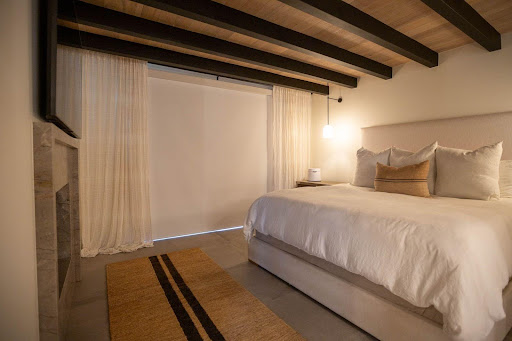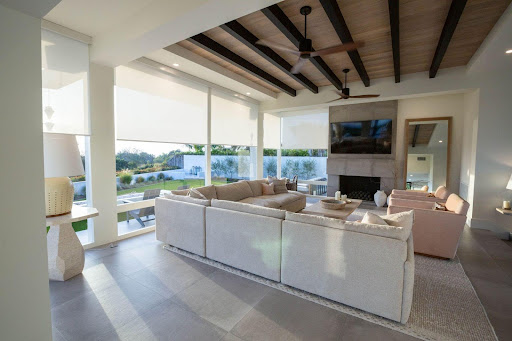When decorating your home, you want to ensure you get every single detail right – not only for the home’s aesthetic but for various functional reasons that can create the best in-home experience in your living space.
A big part of setting the ambiance of your home involves selecting window treatments, a decision that transcends mere decoration to impact your home’s lighting, energy efficiency, and overall atmosphere.
On the topic of window coverings, the big debate usually lands on shades vs. blinds. Both offer distinct advantages in functionality and style. We will dive into what sets them apart and determine which one might be the ideal choice for your space.
Let’s get started.
Shades vs. Blinds: Aesthetic Properties
The first thing you’ll notice with shades vs. blinds is their construction, although the function is similar, they are different.
Shades are designed from softer textiles to create one continuous piece of fabric. On the other hand, blinds are made of slats that unfold to let light in.

This fundamental design difference leads to two distinct aesthetic experiences:
- Visual appearance
- Shades create a solid, modern appearance, providing your windows with a smooth, uninterrupted covering that blends seamlessly into your space.
- Blinds tend to look more mechanical and rigid. You can see the seams where blinds come together to block light.
- The influence on a room’s lighting
- Opting for shades means that you can have several options when it comes to the amount of light you want to let into your home. We offer blackout shades, which blocks out 100% sunlight and solar screen shades, providing a beautiful stream of natural light that partially blocks out the suns’ harsh rays. When you fully draw up your shades, you can enjoy full view outside your home.
- With blinds, that light is broken up when you open them up vertically, because the slats are still there and don’t actually get out of the way (unless you pull them fully aside, but there is still a large chunk of material on the side that they are pulled to.
Shades vs. Blinds: Effects on Lighting
Shades and blinds also have different characteristics regarding how they affect lighting. It’s not just visual.
Shades can affect the natural lighting and energy entering your home differently. Depending on the type of fabric, shades can either completely block out light and visibility from the outside for unmatched privacy (such as blackout window shades), or you have shades that let in plenty of natural light while blocking out heat and conserving energy used for HVAC (such as solar screen shades).

There are a lot of different effects shades can have, allowing you to customize each room to meet the specific look and feel you are aiming for.
In comparison, blinds are typically made from materials like plastic or wood, and they work on a simple principle: pull them up for full sunlight or adjust the slats to dial down the brightness. Some can help slightly with energy conservation, but your lighting choices and how that lighting is affected tend to break down between full, unfiltered lighting and nothing at all.
Shades vs. Blinds: Considering Operations
When considering the operational aspects of shades versus blinds, it’s important to consider their respective mechanisms and functionalities.
Blinds typically feature slats that can be adjusted to control the amount of light entering a room. However, the presence of these slats makes blinds heavier compared to window roller shades. This weight disparity can influence ease of operation, especially when manual adjustments are required.
Moreover, window shades offer a lighter alternative and often come with motorized options for enhanced convenience. Motorization allows users to control the shades with the push of a button or even remotely, adding a layer of sophistication and automation to the living space. This feature can be particularly beneficial for individuals with limited mobility or those seeking seamless integration of smart home technology into their living environment.
Furthermore, the operational differences between shades and blinds extend to their overall maintenance and durability. While blinds with slats may require regular cleaning and upkeep to prevent dust accumulation and ensure smooth operation, window shades typically have a simpler design that is easier to maintain. This simplicity not only streamlines maintenance efforts but also contributes to the longevity of the window treatment, minimizing the need for repairs or replacements over time.
Overall, considering the operational aspects of shades versus blinds can help homeowners make informed decisions based on their specific needs and preferences.
Final Verdict: Which One is Better?
After weighing the pros and cons of shades vs. blinds, it’s evident that shades hold a winning edge for those looking for top-tier window treatments.
The beauty of shades lies in their versatility—they can give each room its unique touch, both in style and functionality. Shades not only offer more value but also higher quality. Their seamless design, typically consisting of a single piece of fabric, means fewer moving parts and less wear and tear over time.
In contrast, with their array of slats and intricate mechanisms, blinds may not stand the test of time as gracefully, potentially leading to earlier replacements.
Additionally, the maintenance and cleaning of blinds, compared to shades, is much more time-consuming. Shades are quick and easy to wipe down with a damp cloth and require very little cleaning to keep them looking beautiful. The slats of blinds quickly attract dust and require much more cleaning over the years.
For unparalleled window coverings tailored to fit your space’s unique dimensions and aesthetic, The Shade Reserve stands ready to assist. Discover our bespoke window shade solutions and elevate your interiors with both style and substance.

